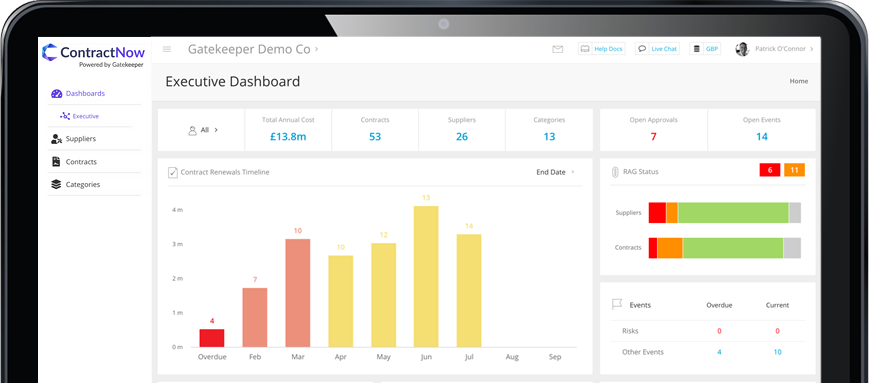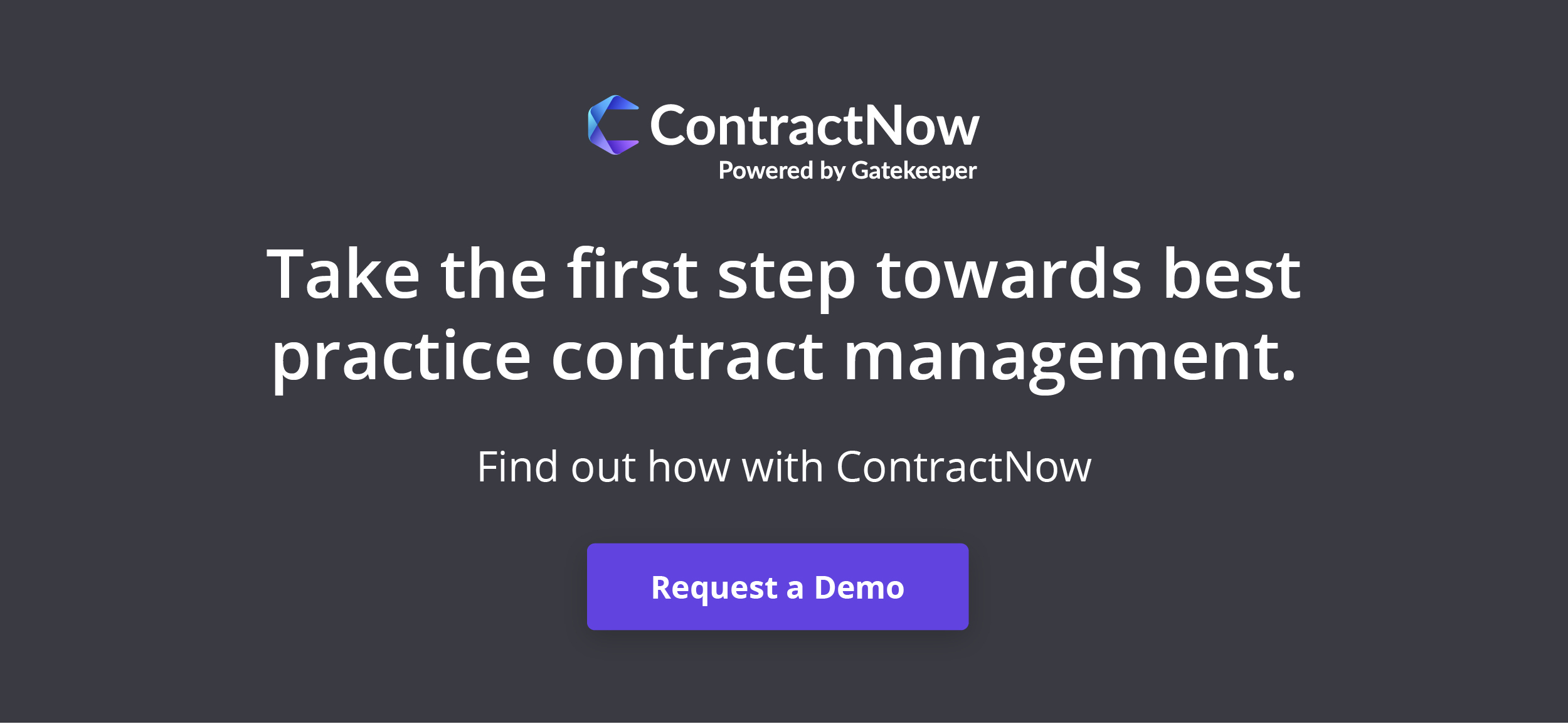Microsoft Excel offers an accessible way for businesses to manage their contracts. It’s an easy way for everyone across the business to capture data from contracts, easily shareable and easy to edit as and when needed.
This often makes spreadsheets the first and natural choice for businesses when it comes to contract management. We've created some Excel contract management templates to support businesses with their endeavours.
But the simplicity of managing contracts through Excel has its trade-offs.
Below we take a look at some of the most serious risks of using Excel spreadsheets, how it can negatively impact your contract management processes and why your business should consider adopting a dedicated contract management software.
1. A lack of centralisation can lead to hidden risks
Data entry into Excel spreadsheet is pretty easy. You can create sections for vendors, contract types, value and monitor dates to prompt action around renewals.
As such, it can be easy to fall into the illusion that your contracts and their metadata are all being held in one place.
However, depending on where that Excel sheet is stored and who has access, it can easily be edited unexpectedly, or duplicates created and saved separately. This can mean that the valuable data stored within them, such as renewal dates, can be lost or missed, with negative outcomes for the business.
The ease with which spreadsheets can be created and edited is both their strength and their weakness when it comes to contract management."
Yes, they’re a quick and easy starting point but they can quickly lead to data fragmentation, preventing a single source of truth from being achieved across the business.
The metadata captured in a spreadsheet is also at the mercy of manual entry. Anyone inputting the data can easily make a mistake, key in the wrong figures or dates or even miss key information.
These inaccuracies can lead to a lack of understanding further down the line, particularly in relation to contract obligations.
This then leads on to the scenario of “you don’t know what you don’t know” when it comes to reviewing and monitoring contracts. This lack of visibility can then lead to some of the following scenarios going undetected:
- Poor supplier performance
- Obligations not being met
- Missing documents needed for compliance
- Duplicate or delinquent spend
- Unwanted, auto-renewals on contracts
Dedicated contract management software helps solve these issues. It can provide a secure central contract repository that increases visibility across the organisation.
It can be easily searched, accessed by the right people and simplifies other areas of contract management such as performance reporting.
Contract management solutions that offer automated processes such as AI extraction also create a more efficient and accurate way to capture contract metadata.
 Gatekeeper's Contract Repository
Gatekeeper's Contract Repository
2. Administrative workload takes you away from your job
Using Excel spreadsheets requires completely manual work, ranging from data entry to sending the file via email to relevant parties.
Each time a contract’s metadata changes – whether that’s key dates or an agreed obligation – time needs to be taken away from your key focus to manually update the spreadsheet to reflect the changes.
The more your business grows, or the more complex your contracts become, the more time will need to be spent working within Excel spreadsheets."
Not only does this cause a time sink but this contract administration prevents people from focusing on their actual job (particularly within the Legal team) and working towards the business’s overall objectives.
These frustrations can lead to risks within themselves such as those responsible for data entry choosing to leave it on the back-burner while they focus on their main role.
This can quickly create gaps in contract management which can result in more severe risk – such as key contacts, dates or clauses being recorded.
To move away from Excel and allow teams to focus on what their KPIs or goals are, you should consider a dedicated contract management software as it will automate your processes.
Automation can remove the need for manual intervention, cut the time spent on contract administration and also keep you alerted to upcoming key dates.
Automation creates greater efficiencies as tasks are completely faster and company-wide collaboration is enhanced. Contract management software also gives the added benefit of visualised processes through a workflow engine and provides a full audit trail of each touchpoint for future reference.
3. Poor version control can lead to lack of all control
Opting to use Excel spreadsheets rather than a dedicated contract management software limits version control capability. Once the spreadsheets are emailed out, anyone with access can make edits – without any audit trail of doing so. These edits are also unlikely to be connected to a master document.
You can be left with a number of scenarios - such as overwritten spreadsheets, different versions existing in different locations and crucial edits that simply haven’t been captured. Key changes to obligations that aren’t captured can have a negative impact on supplier relationship and performance.
Spreadsheets may feel like a natural choice for many businesses, but the inability to track user access or changes can cause an increase in overall contract risk throughout the business."
If you recognise these issues, it might be time to consider a contract management software that provides a clear audit trail of any and all edits made.
4. Creating a single point of failure
Not everyone has time for contract administration, especially when it comes to updating spreadsheets. In fact, too many people editing one document can lead to multiple errors, versions and issues.
Most businesses counter these issues by becoming over reliant on an individual who understands the nuances of their spreadsheet and how best to maintain it.
Relying on the guardian of the spreadsheet is risky, especially if this individual is out of the business for a period of time or leaves the business permanently."
Unless a thorough handover is in place, the business will be left with a spreadsheet that nobody else knows how to work.
Contract management software standardises, digitises and automates ways of working – so control can be achieved and maintained across the entire organisation. Intuitive and easy to use, CLM software can be accessed and used by multiple teams who will all follow the same best practices every time they work with a contract.
5. A lack of alerts can lead to a lack of action
Spreadsheets don’t just require manual data entry. They require manual monitoring too. Constant reviews of the information you have need to be scheduled into your planning to ensure that key dates – especially around renewals – aren’t missed.
However, this is another administrative task that increases workload for specific individuals.
As a result, spreadsheet reviews are likely to fall to the wayside while more pressing matters are attended to. Renewals, up-sell and cross-sell opportunities and even delays in the signing process can all be missed, with the business being none the wiser.
This can result in financial losses, the loss of a key vendor and instances of overspending.
A lack of automated alerts can also result in a lack of compliance as certificates pass their valid-until date and aren’t replaced or updated."
Contract management software not only lets you see everything in one place but it also sends automated reminders and notifications to different stakeholders, allowing the business to take action ahead of time and always be in the strongest position.
If you’re ready to move beyond Excel spreadsheets or want to know more about how contract management software can enhance your processes, contact us today.




